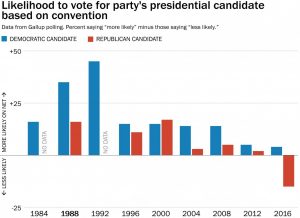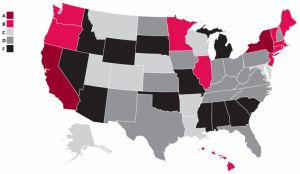Donald Trump’s domination of the headlines with mounting outrages has served as a highly convenient distraction for the GOP; Much of the media and the public believes it is all about him, and he is dragging his poor party down into the fever swamps. Thus the Republicans escape accountability for their Frankenstein.
But Jeet Heer, a senior editor at The New Republic, isn’t having it. He brings a moment of clarity to the 2016 presidential campaign in his TNR post arguing that “The Republican Party, no less than its nominee, is incapable of accepting the Democratic Party’s right to rule.” As Heer explains:
As shocking as it was, Donald Trump’s suggestion that “Second Amendment people” would be able to deal with Hillary Clinton and the judges she appoints—a clear appeal to political violence—should not be seen as the nadir of his candidacy. Rather, it was part of his larger pre-emptive attack on the legitimacy of Clinton’s presidency. The “Second Amendment” talk is of a piece with his claims that the election is being “rigged” against him. Trump is poisoning the well, so that even if Clinton wins, she’ll govern over a population in which a significant minority rejects the notion that she has the right to rule at all.
Yet the coming legitimacy crisis won’t be solely Trump’s fault, even if he’ll deserve the bulk of the blame. As in so many other areas, Trump is merely pressing to their logical conclusion ideas that have been advocated by the last generation of Republicans, albeit more subtly. In truth, the last time Republicans wholeheartedly accepted the legitimacy of a Democratic president was Jimmy Carter in the late 1970s. Since then, both Bill Clinton and Barack Obama have faced repeated attacks from an opposition that refused to fully accept their victory as final. Clinton had to fend off ginned-up scandals that suggested he and his wife were crooks and murderers, while Obama has had to contend with birthers who think he has no legal right to be president and conspiracy theorists who believe ACORN stole the election on his behalf.
Heer adds that “It wasn’t Trump who created the bogeyman of voter fraud, which resulted in laws making voting more difficult. That’s a mainstream Republican position, advocated in the respectable pages of The Wall Street Journal and enacted into laws by Republican governors across America, in states like North Carolina and Wisconsin.”
Regretfully, it’s not only Republicans who are entertaining the bogeyman delusion, says Heer. “Both Hillary Clinton and Barack Obama have gone out of their way to say that Trump is not a normal Republican, in the hopes that they can shake loose Republican votes. But after the election, this polite fiction has to end. We need to confront the fact that Trump, as extreme as he is, is all too representative of his party.”
And those who think that defeating Trump will end the GOP-driven “legitimacy” crisis are going to be disappointed. “If Trump isn’t the only cause of the legitimacy crisis, then his defeat in November won’t be the cure for it either. America has a political problem that goes deeper than Trump: The Republican Party refuses to accept the fundamental idea that when it loses an election, it has to accept the results.”
“The Republican Party has been recklessly playing with matches for more than two decades,” concludes Heer. “Now they’ve handed over a flamethrower to a pyromaniac. However scary Trump might be, the GOP desire to burn everything down long precedes him.”
It’s really about the modern Republican party’s core contempt for democracy. For them, it’s all about destruction of the adversary in the pursuit of absolute authority, even if their refusal to negotiate in good faith damages the health and well-being of millions of citizens. And when they lose, their strategy is to undermine the very legitimacy of the election and its consequences.
Today’s GOP would no longer be recognizable to Republicans who voted for Eisenhower, let alone Teddy Roosevelt or Lincoln. We can do our best, however, to insure that they will be so badly beaten in November that a few of the GOP survivors will see the folly of their party’s flirtations with anarchy, and return to the more patriotic conservatism that once empowered their best leaders.





